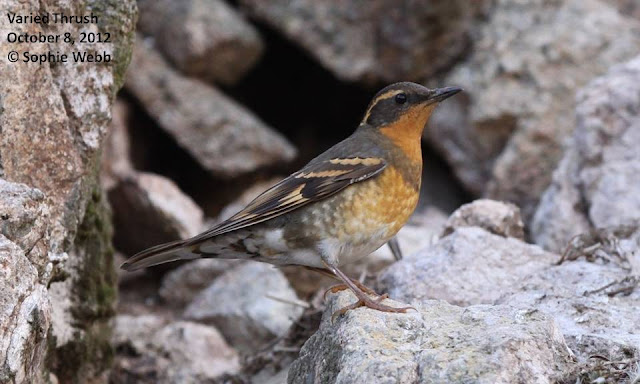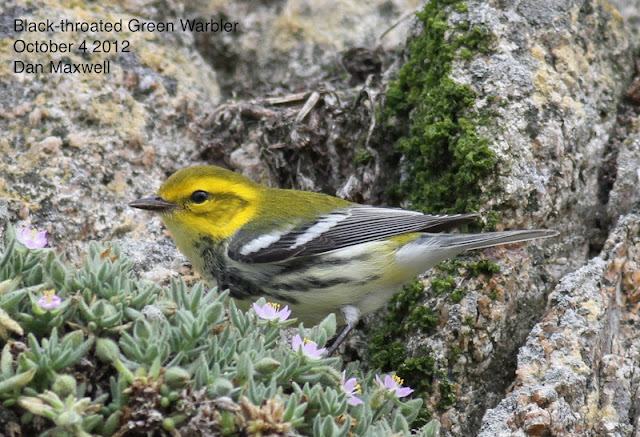Since the Farallonathon, we have been quite busy counting and banding good numbers of migrant birds. On Oct 5th, this juvenile tundrius Peregrine Falcon rested briefly on the island before continuing south.
On the 7th, we captured an apparently pure Yellow-shafted Flicker female and at the same time a male Flicker Intergrade. On the Farallones, pure Yellow-shafted Flickers are a bit rarer than intergrades, but usually average about one a year. Note how the intergrade on the left has a bit of orange on the underwings, a red and black malar mark, and blue and brown on the face. The yellow-shafted has pure yellow underwings and an entirely brown face and throat.
On the 7th, we captured an apparently pure Yellow-shafted Flicker female and at the same time a male Flicker Intergrade. On the Farallones, pure Yellow-shafted Flickers are a bit rarer than intergrades, but usually average about one a year. Note how the intergrade on the left has a bit of orange on the underwings, a red and black malar mark, and blue and brown on the face. The yellow-shafted has pure yellow underwings and an entirely brown face and throat.
This same day we captured a juvenile male Black-throated Blue Warbler, which was still present the following day. Check out those pointed rects (AKA, tail feathers)!
Also present on the 8th was a female Varied Thrush.
And the Red-breasted Nuthatch invasion continued strong until about the 20th of October. On the 12th, we banded and tallied 53 of these nasal honkers.
On the 10th, we found our 2nd Black-and-white Warbler of the fall creeping about on the rocks with the nuthatches.
A nicely overcast day on the 11th and 12th brought lots of new birds, dominated mostly by a huge influx of Red-breasted Nuthatches and Ruby-crowned Kinglets. The vegetation around the mistnets was swarming with these guys and kept us all very busy. On the 11th we estimated there were at least 40 of these kinglets, and on the 12th, our estimate was 78!
The highlights of the day, though, were the island's 3rd record of Yellow-bellied Sapsucker and 6th record of Evening Grosbeak! Both birds were first seen at the lighthouse. The sapsucker was not seen elsewhere, but the grosbeak eventually flew into our mistnet. Luckily, a camera was handy at the lighthouse to document these birds as soon as they landed because you never know if they will be seen again. For the sapsucker, there was a bit of indecision at first as to whether it was a Yellow-bellied or Red-naped, because, despite the lack of red on the nape, we were uncertain as to whether a juvenile Yellow-bellied could begin its pre-formative molt this early. Thankfully, several sapsucker experts viewed the photos and concurred that it was a probably a pure Yellow-bellied. Furthermore, an article by Mlodinow et al. (Birding, 2006), pointed out that nearly all Red-naped Sapsuckers have a red nape by October 1st.
The Evening Grosbeak was an adult male!
We also found our first Purple Finches of the season. Here's an adult male that was present with 4 streaky birds that were either females or immature males.
In addition to birds, we caught our 2nd Hoary Bat of the season!
On the 12th, we did not find any mega-rarities, but it was the biggest day of the fall, with at least 617 landbirds recorded on the island. High counts for the year were recorded for Violet-green Swallow (125), Red-breasted Nuthatch (53), Ruby-crowned Kinglet (78), Myrtle Warbler (29), White-crowned Sparrow (48), Golden-crowned Sparrow (85), and Oregon Junco (52).
Here's a juvenile Violet-green Swallow in heavy molt. Check out the molt-limits in the wings!
One noteworthy bird found this day was a Sabine's Gull that was plucked off the water by a Peregrine Falcon. Unfortunately, the only person who got to see the gull was the person shooting the photos. This was only our second Sabine's Gull of the year.
Also nice to see was a late Ash-throated Flycatcher.
And our first Swamp Sparrow of the year was bopping about our yard:
On the 13th, the clouds broke and the winds started blowing out of the northwest, but we continued to get good numbers of birds and even a couple rarities showed up. During the morning pelican survey, we spotted an adult Brown Booby perched on Sugarloaf Islet. Apparently, this bird was seen the previous day at Pt. Reyes. The last person to see it said it was heading southwest, "perhaps in the direction of the Farallon Islands." Nice guess! With the gannet on Sugarloaf too, we had a two Sulid day! How many times has that happened in California?
Later in the afternoon, we found our 2nd Black-throated Green Warbler of the fall, only this time it was found in a mistnet, so its identity was greatly simplified and photographing it was a cinch.
We also had two more White-tailed Kites show up, which makes 13 and 14 for the year. From 1967 (when PRBO started surveys on the Farallones) to 2000, there had only been 23 kite sightings. From 2000 to 2011, we have seen 36. What could be causing this increase? Is kite habitat improving on the mainland? It seems unlikely since they require open grasslands (preferably ungrazed) for foraging; golf courses, vineyards, and housing developments destroy kite habitat. It would be interesting to know if the autumn hawkwatch at the Golden Gate Raptor Observatory is also seeing more kites. Anyway, this bird can be identified as a juvenile by the rusty feathers still present on its underparts.
The 14th to the 16th saw many landbirds depart. A few lingering birds provided nice photos. Western Meadowlarks usually arrive during October and many can hang around to over-winter.
This Chestnut-sided Warbler first arrived on the 6th and put on a gram of fat in a week. It was last seen on the 19th.
On the 17th, the weather began to improve and several more arrivals found the island. Brown Creepers are uncommon fall migrants on the island.
This Barn Owl has been lingering around on the island all fall. It has been shifting its roost every few days, so we don't always find it.
The 18th ended up being a pretty nice day. This snipe had quite a bit of white on the trailing edge of the wing. This could be a Common Snipe from Eurasia, but without a photo of the underwing, we'll never know.
Late in the day, this juvenile Brown Booby rode up to the island on a fishing boat. While it was approaching, we thought it might be a Red-footed Booby. The sharply cut hood across the breast and the white mottling on the underwings clearly identified this bird as a Brown Booby. Three species of Sulid in one day on the Farallones will have to happen some other day.
Late in the day, a Harris's Sparrow was found flocking with a couple juncos on the outskirts of our survey area. Just before sunset, a Grasshopper Sparrow was found at this same location from somebody looking for the Harris's Sparrow.
Lastly, on the 19th, the longspur that had been poorly seen the previous two days was photographed and identified as a Lapland.
The weather turned ugly on the 20th with howling northwest winds that blew all day on the 21st too. Although this weather and the storm that followed weren't good for bringing landbirds to the island, we finally started seeing Buller's Shearwaters, with 300 counted on the 20th and 240 on the 22nd. Fulmars have also increased, and we are seeing good numbers of Black-vented Shearwaters. Hopefully the landbird migration will increase again once the weather settles back down.




















































